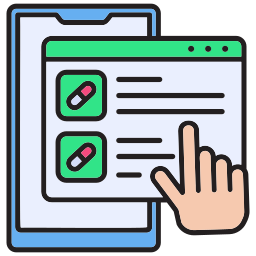Epic Integration is the term used to describe the digital solution that enables healthcare professionals to access real-time patient health data obtained directly from the Epic EHR system. Epic shares 36% of the market in the USA.
Healthcare professionals can now quickly and easily access important patient data, such as medical history, prescription and medication details, past and current contacts, and possible future appointments, thanks to this Epic integration.
Hospitals looking to improve their operations will find Epic EHR integration as a game-changer. By integrating Epic EHR, hospitals can access real-time data, merge patient health data, and improve care management and delivery.
Epic EHR is a comprehensive platform that combines medical histories, treatment plans, and diagnostic results in one place, significantly enhancing the accuracy of diagnoses and treatments.
Epic EHR integration simplifies clinical workflows and amplifies patient involvement by providing access to their health data. It establishes informed and active participation in their care journey, improving outcomes and patient satisfaction.
For decision-makers in healthcare, leveraging the capabilities of Epic EHR is important for driving efficiency, improving patient care, and staying ahead in the competitive healthcare market.
Let's get to know why you should integrate with Epic EHR!
Why Epic EHR Integration?
Epic EHR integration allows hospitals to consolidate patient health data in real-time, leading to more accurate diagnoses and treatments. Its integration ensures that all patient information is accessible on one platform, enhancing the overall efficiency and effectiveness of healthcare delivery.


✅ Improving Patient Experience and Care
With Epic EHR integration, patient care is elevated through seamless access to extensive health records. Patients can review their medical histories, treatment plans, and test results, promoting active involvement in their healthcare journey. It promotes trust and involvement, which improves overall patient happiness and results.
✅ Simplifying Medical Procedures
By integrating Epic EHR, clinical workflows are modernized through the automation of routine tasks and the reduction of manual data entry. Healthcare providers benefit from rapid access to updated patient information, facilitating faster and more coordinated care. It also reduces administrative responsibilities, freeing doctors to focus more on patient care.
✅ Interoperability Across Healthcare Networks
The powerful interoperability features of Epic EHR integration ensure that communication and data sharing are seamless across several healthcare systems. It also allows for coordinated care across several providers, improving teamwork and ensuring that patients receive consistent and complete treatment regardless of where they are treated.
✅ Data-Driven Decisions
Epic EHR integration provides healthcare decision-makers with real-time data analytics and reporting tools. The data-driven strategy enables informed decision-making, optimal resource allocation, and improved patient outcomes. Access to accurate and timely data supports strategic planning and enhances the overall performance of healthcare facilities.
✅ Regulatory Compliance and Security
The integration of Epic EHRs ensures patient data handling is in line with applicable healthcare laws and regulations. It employs comprehensive security measures to protect sensitive information, ensuring patient confidentiality and data integrity. Compliance with regulatory regulations reduces legal risks while increasing trust in the healthcare system.
Popular Methods for Epic Integration
Epic EHR integration can be achieved through various methods, each with its benefits and considerations.
Here, we discuss two popular methods for integrating Epic EHR into hospital systems.
👉 Direct Integration with Epic
Direct integration with Epic involves connecting hospital systems directly to the Epic EMR platform. This method ensures real-time data exchange, providing immediate access to patient information across various departments.
Healthcare providers may improve data consistency and dependability by using Epic's native APIs. It also allows hospitals to customize workflows and connect the Epic EHR integration system with their operational demands. However, direct integration can be complex and may require substantial IT resources and expertise to implement and maintain.
👉 Middleware Integration with Epic
Middleware integration involves using an intermediary software layer that connects hospital systems to the Epic EHR platform. Middleware solutions can simplify the integration process by handling data translation, transformation, and routing between disparate systems. This method can reduce the complexity and cost of integration while still providing robust data exchange capabilities.
Middleware integration can also facilitate interoperability with other healthcare systems and applications, enabling a more cohesive healthcare ecosystem. While this approach may offer greater flexibility, it may also introduce additional points of failure and require ongoing management and support to ensure optimal performance.
Weighing the Options: A Comparative Analysis for Epic Integration
Choosing the right method for Epic EHR integration involves weighing the pros and cons of different approaches. Below, we compare direct and middleware integration to help decision-makers evaluate their options.
Direct Integration

Pros of Direct Integration:
Direct integration involves connecting hospital systems directly to the Epic EHR platform, which can offer several benefits. In-house development teams can create highly customized solutions tailored to the specific needs of their healthcare facility.
This Epic EHR integration method allows for real-time data exchange and high data consistency, ensuring that patient information is always up-to-date. Additionally, direct integration enables Epic’s native APIs, facilitating seamless data flow and process automation within the hospital’s existing infrastructure.
Cons of Direct Integration:
Direct integration comes with its challenges. The complexity of the integration process can be daunting, requiring significant time and resources to develop and implement. Hospitals often need to hire dedicated development teams and subject matter experts, which can be costly.
This method also poses the risk of vendor lock-in, where hospitals heavily rely on Epic's technology and support. The development and maintenance efforts required can lead to increased operational costs and potential delays in achieving the desired outcomes.
Middleware Integration
Pros of Middleware Integration:
Middleware integration offers several benefits for hospitals looking to connect their systems with Epic EHR. This approach provides flexibility, allowing hospitals to integrate various applications without extensive modifications to their existing infrastructure. Interoperability is another significant advantage, as middleware facilitates communication between disparate systems, ensuring smooth data exchange.

Scalability is also a key benefit; middleware solutions like HealthConnect CoPilot can grow with the hospital's needs, accommodating increased data volumes and additional functionalities. This method supports efficient and cohesive integration, enhancing overall system performance and the user experience.
Cons of Middleware Integration:
Despite its advantages, middleware integration has its challenges. One common issue is the potential for increased complexity in managing multiple systems and interfaces. Middleware solutions require thorough configuration and ongoing maintenance to ensure they function correctly and continue to meet integration needs.
What are EHR Integration Challenges?
EHR integration, while valuable, presents challenges. These include technical hurdles like incompatible data formats and complex data mapping, workflow disruptions due to cost and staff training needs, and data concerns around privacy, security, and accuracy.


❌ Complexity of EHR Data Model
The EHR data model is intricate, encompassing diverse patient information and clinical workflows. This complexity can lead to challenges in data management, analysis, and integration with other systems.
❌ Limited Support for Standards like HL7 and FHIR
Many EHR systems offer limited support for standards such as HL7 and FHIR. This restriction hampers interoperability and data exchange between different healthcare systems and applications.
❌ Security and Compliances
Ensuring data security and compliance with regulations like HIPAA is critical in EHR systems. These requirements add layers of complexity to EHR management, requiring stringent controls and regular audits.
❌ Legacy System Compatibility
Integrating EHR systems with older legacy systems can be challenging due to differences in technology and data formats. This incompatibility often results in additional costs and time-consuming modifications.
❌ Complex Integration Process
The process of integrating EHR systems with other healthcare applications and systems is often complex. It involves meticulous planning, testing, and coordination to ensure smooth and accurate data flow.
HealthConnect CoPilot: Resolving Your Integration Challenges Efficiently
HealthConnect CoPilot simplifies the integration process for hospitals using Epic EHR integration, addressing common challenges and ensuring efficient EHR integration.
What is HealthConnect CoPilot about?
HealthConnect CoPilot is a middleware solution designed to facilitate the integration of various healthcare applications with Epic EHR integration. It acts as a bridge, allowing different systems to communicate effectively without extensive modifications.
This tool is used to meet the unique needs of healthcare providers, ensuring data flows smoothly between systems. Through simplified integration, HealthConnect CoPilot helps hospitals maintain continuity and accuracy in patient records, improving overall efficiency and patient care.
Use Cases
HealthConnect CoPilot is used in several scenarios to improve hospital operations. For instance, it connects laboratory systems with Epic EHR, ensuring test results are promptly and accurately updated in patient records.
Another use case is integrating third-party telemedicine platforms, which allow consultation data to be easily transferred to the patient’s EHR. Additionally, it supports the integration of patient monitoring devices, ensuring continuous data flow into the Epic system for real-time monitoring and better-informed clinical decisions.
Benefits of HealthConnect CoPilot
HealthConnect CoPilot offers hospitals and healthcare organizations flexibility, interoperability, scalability, and administrative burden reduction.
Here are some benefits of HealthConnect CoPilot, which helps healthcare businesses.
Flexibility: Integrates EHR with various systems without overhauling existing infrastructure.
Interoperability: Ensures smooth data exchange, maintaining accurate patient records.
Scalability: Grows with hospital needs, handling increased data and functionalities.
Reduced Administrative Burden: Automates data transfer, reducing staff workload.
Improved Efficiency: Streamlines workflows, enhancing operational efficiency and patient care.
Choosing the Right Epic EHR Integration: Key Factors to Consider

Selecting the right integration method for Epic EHR involves evaluating your hospital’s specific needs, current infrastructure, and long-term goals. Understanding these factors ensures a smooth integration process and maximizes the benefits of your EHR system.
1️⃣ Specific Needs and Use Cases of Your App
When choosing an integration method for Epic EHR, consider the specific needs and use cases of your hospital's applications. For example, if your hospital relies heavily on real-time data from wearable health devices, ensure the integration method supports continuous data flow and immediate updates.
Additionally, consider the types of data your applications handle. If they require secure transmission of sensitive patient information, prioritize integration methods that offer robust security features.
Evaluate the compatibility of your existing systems with Epic EHR integration to avoid extensive modifications. Finally, consider scalability if your hospital anticipates growth or increased data volumes, ensuring the chosen method can accommodate future needs.
2️⃣ Development Resources and Expertise for Epic EHR Integration
Choosing the right development resources and expertise is crucial for successful Epic EHR integration. Hospitals need to assess the skill sets of their in-house IT teams and determine if they have the experience necessary for complex integrations. Often, it may be beneficial to partner with experienced third-party vendors like Mindbowser, which specializes in EHR integration.
These vendors bring a deep understanding of Epic’s architecture and best practices, ensuring a smoother and more efficient integration process. By harnessing specialized expertise, hospitals can minimize disruptions, reduce the risk of errors, and ensure that the integration supports their clinical and operational objectives effectively.
3️⃣ Long-Term Scalability and Interoperability Goals
For decision-makers in hospitals, achieving long-term scalability and interoperability with Epic EHR integration is paramount. It involves planning for future growth and ensuring that the systems can expand seamlessly as patient volumes and data complexity increase.
Interoperability aims to integrate Epic EHR with other systems across healthcare networks, facilitating data exchange and improving care coordination. By strategically aligning integration efforts with scalability and interoperability goals, hospitals can adapt to evolving healthcare demands while maintaining operational efficiency and enhancing patient care outcomes.
Epic EHR integration is crucial for hospitals to streamline operations and enhance patient care. By aligning technology with organizational objectives and patient care goals, hospitals can improve data management and interoperability across healthcare networks. It improves clinical decision-making and operational efficiency, allowing for prompt and effective treatments. Investing in solutions like HealthConnect CoPilot helps hospitals achieve long-term healthcare delivery goals.
Mindbowser excels in achieving seamless integration for optimized healthcare delivery by leveraging expertise in Epic EHR integration. Our team focuses on creating efficient, interoperable systems that streamline clinical workflows, improve patient care, and ensure data-driven decisions. With a commitment to security and compliance, Mindbowser empowers healthcare organizations to enhance operational efficiency, reduce costs, and deliver superior patient outcomes through innovative technology solutions.
If you want experts to help with Epic integration, HealthConnect CoPilot is here to help. To learn more, contact us now.
- What are Epic integrations?
Epic EHR integrations involve connecting Epic's electronic health record (EHR) system with other healthcare applications and systems to enable seamless data exchange and interoperability. These integrations help streamline workflows, improve patient care, and ensure that healthcare providers have access to comprehensive patient information across different platforms.
- How long does it take to integrate Epic?
The required time for Epic EHR integration can vary depending on the complexity of the project and the systems involved. Typically, it can take anywhere from a few months to over a year to complete a full integration. Factors such as the scope of integration, resource availability, and customization needs will influence the timeline.
- What is Epic FHIR?
Epic FHIR (Fast Healthcare Interoperability Resources) is a standard for exchanging healthcare information electronically. It allows for easier and more efficient data sharing between Epic and other systems, promoting interoperability. Epic FHIR enables developers to create apps that can access and use data from the Epic EHR, enhancing functionality and improving patient care.
- What is EHR integration?
EMR (Electronic Health Record) integration involves connecting different EHR systems or integrating EHRs with other healthcare applications. This process ensures that patient information is consistently updated and accessible across various platforms. Epic EHR integration improves clinical workflows, enhances data accuracy, and facilitates better communication and coordination among healthcare providers.

Pravin Uttarwar, CTO of Mindbowser
As the CTO of Mindbowser, a healthcare-focused software development company, I am dedicated to delivering cutting-edge digital solutions that transform patient care and operational efficiency. With over 16 years of experience and as an MIT alumnus, I specialize in healthcare interoperability, FHIR-compliant systems, and AI-powered platforms, crafting scalable products and architectures tailored to the unique needs of healthcare providers and enterprises.
I have spearheaded the development of over 100 products and platforms, guiding them from concept to full-fledged solutions. My expertise extends to scaling remote tech teams, driving EHR integrations, and building secure, cloud-native healthcare solutions. By shaping technology visions and roadmaps, I help clients achieve long-term growth and success in the rapidly evolving healthcare landscape.
HealthConnect CoPilot enabled us to access real-time patient health data through integration with Apple HealthKit, enhancing care delivery while maintaining HIPAA compliance. This led to personalized care and improved outcomes for patients.

AI-enhanced Obstetrics Clinical Decision Support Platform
HealthConnect CoPilot's integration with Epic's Hyperspace has transformed our workflow. Automated post-delivery examinations and HL7 protocol use ensure accurate updates to Epic. Their expertise empowers informed decision-making in childbirth

Top Provider for Customized Healthcare Solutions
HealthConnect CoPilot's helped us to integrate with leading tracking devices such as Apple Watches and Fitbit. This integration enables effortless syncing of health data, providing users with real-time insights displayed directly on our flagship products: smart mirrors and digital calendars.

A Provider of Customizable Display Solutions
Post a comment Cancel reply
Related Posts
Ambulatory EHR vs Inpatient EHR: Which One is Right for Your Practice?
EHRs help doctors and healthcare staff store, access, and manage patient information digitally. They improve…
Ambulatory EHR: A Complete Guide for Healthcare Providers
Healthcare providers are moving beyond paper records and legacy systems, and ambulatory EHRs are leading…
Epic Integration with SMART on FHIR: A Complete Guide
The challenge of integrating AI-driven tools and third-party applications with Epic’s EHR system has long…
Epic EHR Integration – Unlocking Seamless Healthcare Connectivity
The EHR integration has revolutionized healthcare by enabling secure, real-time access to patient data. Epic…
Epic FHIR Integration: Making Interoperability Seamless for Healthcare Providers
Healthcare systems generate massive amounts of patient data daily, but without Epic FHIR integration, this…
Epic EHR Explained: How It Transforms Healthcare Operations and Patient Care
Epic EHR has become a cornerstone of modern healthcare, providing hospitals and clinics with a…










